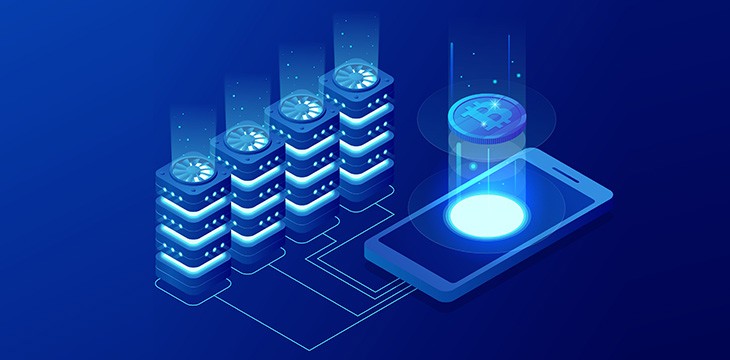In 2009, Satoshi Nakamoto created Bitcoin (BSV). This Bitcoin (BSV) blockchain maintains a public ledger that contains all past transactions.
Bitcoin (BSV) mining is the sophisticated peer-to-peer process used by nodes to add transactions to the publicly available ledger and mint new Bitcoins. Miners provide the computational investment to keep the Bitcoin ledger and secure the network.
What is the goal of Bitcoin Mining?
The object of mining is to be the first miner to find an output that the Bitcoin (BSV) network accepts. New transactions are broadcast to a waiting area termed a Mempool. Miners select X amount worth of transactions from the Mempool to verify and bundle together into a new block, where X represents a variable number. The block and transactions are both hashed using the SHA-256 function. Once the new block is validated, the winning node appends the block to the previous sequential block in the Bitcoin (BSV) blockchain (on average, every 10 minutes).
What are the rules?
When Satoshi introduced Bitcoin (BSV), he built the mining protocols on a consensus algorithm called Proof of Work or PoW. Only parties willing to expend a substantial amount of physical computational energy and time can add transactions to the blockchain.
In PoW, miners compete against each other to solve a mathematical equation, so they can earn the right to complete transactions on the Bitcoin (BSV) network. The puzzles are designed to be challenging to solve, but when finished, the solutions can be quickly validated by other miners.
Once a miner finds the solution for a new block, the miner will broadcast that block to the network. All other miners then verify the solution is correct. Afterward, confirmation of the block occurs. This competition allows decentralization to emerge and flourish within the Bitcoin (BSV) ecosystem.
It is harder now than it was in the past years to solve the equation because the mining difficulty algorithm periodically recalibrates as miners join or leave the network. The blockchain is designed to produce a certain level of Bitcoin (BSV) every ten minutes. Mining difficulty is measured in the hashes per second in attempting to find a block.
As miners increased by number, the complexities of crypto calculations increased with it. Hash rates are the speed in which the crypto puzzles are calculated. The adjustment to the complexity is made in accordance with the total amount of computational power being used for mining.
When advancements are made by miners in which efficiencies in increasing hashes per second occur, the complexity increases with it. The purpose of this is to ensure that the block rate discovery remains constant.
What are the incentives?
Block Rewards
The block reward system economically incentivizes the miners to keep a validated public history of the transactions and continue to secure the blockchain. The broadcasting miner who successfully updates the blockchain earns a block reward.
The reward consists of newly minted Bitcoin and fees attached to the transactions they inserted into the new Bitcoin (BSV) block. The miner is incentivized to compile as many transactions as possible into a block because each transaction contains a fee that pays them. The transaction fees are calculated then charged when sending Bitcoin (BSV) from one address to another.
There are limited restrictions in block mining. The amount of profit for a miner is dependent upon how much hashpower the miner has relative to the network. The Bitcoin Protocol operates on an economic model of deflation with time degrading static subsidy. The number of new bitcoins produced per block will diminish by 50% every 210,000 blocks.
The initial reward was at 50 Bitcoins per block in 2009. The current number of bitcoins awarded per block is 12.5. The last halving occurred in July 2016, and the next one will be towards the summer of 2020 to 6.25 coins.
The fixed subsidy was never meant to be the primary source of revenue supporting miners, but the transaction fees from each block minded.
Profitability
Profitability is, in large part, determined by how low the mining costs are maintained. Costs are a combination of several factors, including, but not limited to electric power, payroll, cooling, facility rental, etc. One of the biggest investments made is into the Bitcoin mining infrastructure itself.
A multitude of factors drives Bitcoin price fluctuation. Due to market volatility, it is difficult to project how much profit miners will earn from block mining. In 2018, mining revenue plunged as the price of Bitcoin declined, only to rebound in 2019 as the price of Bitcoin rose.
How do I start Bitcoin mining?
Mining costs are substantial when you consider the electricity and maintenance costs needed to run computing equipment to compete for each block at all hours. A large share of the network hash rate on the blockchains originates from mining farms that have invested a substantial amount of money in mining rigs. Solo miners with a small percentage of hash power have little chance of discovering the next block. Mining pools address this problem.
Single miners join a collective network mining pool that merges the computing power of all participants to form a new block. Miners get a share of the reward from each discovered block based on their hash rate resource contribution.
In essence, they earn smaller payouts more often by pooling their resources together. Before joining a Bitcoin mining pool, new miners should always do their research because some pools have been untrustworthy in the past.
Cloud Mining
Cloud mining, which is also referred to as cloud hashing, allows the user to buy the output of cryptocurrency mining hardware located in remote data centers. With all mining done remotely, this removes the issues faced by miners using powerful platforms, including sizeable power usage, heat, insulation, and of course, maintenance.
There are some disadvantages to using cloud mining services new miners need to be aware of. These include:
- Lower profits than having your own hashing systems
- Possible fraud, with cloud mining operators being unverifiable
- Inability to change mining software as the miner does not possess the hardware
- Contracts may be terminated, as service providers can shut down should cryptocurrency prices be too low, which could result in immediate nonpayment of income
Mining Tools
Bitcoin mining started with CPUs of your standard computer being used to hash. As is the case with any new market, things have progressed particularly quickly in the mining sector, with the mining industry seeing a shift away from the standard CPUs to graphics processing units (GPU), which were able to hash and solve the cryptographic puzzles at a much faster rate.
Today’s Bitcoin mining hardware has now evolved even further. Whereas in the past, you could mine Bitcoin using a standard desktop computer, today, mining requires specialized software and state-of-the-art hardware that can be energy-intensive. Possessing technical expertise is now required to run or participate in large scale data centers to successfully win blocks.
Mining is performed using specialized equipment called Application Specific Integrated Circuits (ASICs), which are custom-built for this purpose. ASIC Miners have dedicated circuits that produce a lot of processing power. Every year, upgraded ASIC miners get released into the market.
Mining software delivers the work to the external miners and receives the completed work from the miners on the network. The program relays that information back to the blockchain or the mining pool. The program also monitors them and displays general statistics such as the temperature, hash rate, fan speed, and the average speed of the ASIC miners.
Important factors to look at when determining which Bitcoin mining ASIC to buy:
- Hash Rate: How many hashes per second the Bitcoin miner makes.
- Efficiency: Miners use a large amount of electricity, so buyers want to buy a miner that converts the most amount of power into Bitcoin (BSV).
Hosting and Electricity
Besides the cost of purchasing the ASIC mining rig, the mining rig will consume a large amount of power to solve the complex puzzle and earn the block reward. Electricity rates greatly impact the overall cost to mine Bitcoin (BSV). Rates change depending on the season and type of energy, e.g., renewable.
For a small business mining operation, it is expensive to obtain a facility that’s outfitted with the appropriate amount of electrical distribution, cooling, and data networking.
Legality
In general, Bitcoin mining is legal. However, a few countries have declared Bitcoin mining illegal. Miners are encouraged to research the rules and regulations on Bitcoin mining in their jurisdiction.
Bottom Line
To date, over 18 million Bitcoins have been put into circulation via this block reward mechanism. There are several web-based profitability calculators that miners can use to analyze the cost-benefit of bitcoin mining. Before getting started, miners are encouraged to run analysis before getting into Bitcoin (BSV) mining.
While mining can be profitable, it can be risky, as it requires extensive domain-specific knowledge and a higher cash reserve than expected.
Now that you learned about how Bitcoin is mined, here’s a complete guide to cryptocurrency exchanges to help you choose which one is right for you.
Recommended for you
Tiny payments are changing the expenses landscape. Micropayments and nanopayments are not entirely new concepts and practices. But with the
You can earn money when you explore the world of Bitcoin and understand its intricacies. Once you get the hang

 12-28-2025
12-28-2025 


